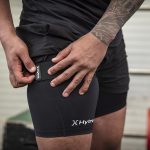Delta Apparel Inc. reported earnings per share for its fiscal second quarter ended March 28 of 19 cents, beating analysts’ estimates by 1 cent while revenue of $96.7 million was in line with Wall Street’s targets—two notable achievements as the coronavirus impacted business in the latter half of the period.
“Our second-quarter earnings reflect our continued focus on driving profitability despite topline challenges faced late in the quarter due to COVID-19,” said Robert Humphreys, the company’s chairman and CEO. “Our vertically-integrated business model with diversified sales channels and broad geographic reach is allowing us to not only continue to operate and generate sales in the current environment but has also created an opportunity for Delta Apparel to support our existing customers and onboard new customers in select channels.
“In light of COVID-19, we continue to prudently manage all aspects of our business with a focus on conserving capital and maintaining strong financial flexibility. We are in a solid financial position to weather the current storm, and I am confident we will emerge from this pandemic stronger, ready to profitably grow our business and continue to provide value for all of our stakeholders.”
For the second quarter ended March 28:
- Net sales were $96.7 million, a decrease of 6 percent from $102.8 million in the prior-year second quarter. Prior to the March impact of COVID-19, the company was on pace to achieve sales growth of approximately 9 percent for the quarter. During March 2020, the closure of retail stores throughout the U.S. dramatically halted revenue during the final month of the quarter. Net sales in the Delta Group segment and Salt Life Group segment decreased 6 percent and 6.3 percent, respectively, from the prior-year period.
- Gross profit was $20.6 million, an 8.8 percent increase from $18.9 million in the prior-year second quarter. Gross margin increased 290 basis points to 21.3 percent versus 18.4 percent in the prior year and increased 60 basis points compared to the first quarter of fiscal 2020. Second-quarter gross profit was reduced by $1.9 million, or 200 basis points, from plant curtailments caused by government-mandated country closures in El Salvador and Honduras in March 2020. Adjusting for these plant curtailment expenses, gross margins would have been 23.3 percent during the March 2020 quarter, an improvement of 490 basis points from the prior year and 260 basis points from the fiscal 2020 December quarter. This margin expansion was attributable to continued efficiencies and process improvements within the Delta Group segment’s integrated vertical manufacturing platform.
- Selling, general and administrative expenses were $17.9 million in the March 2020 quarter compared to $17.1 million in the prior-year second quarter. The increase in SG&A expenses principally resulted from distribution network expansion investments.
- Operating income increased to $3.6 million compared to $2.7 million in the prior-year second quarter as a result of the strong gross margin expansion more than offsetting the lower sales levels and higher distribution network expenses.
- Net income for the quarter was $1.3 million, or 19 cents per diluted share, compared to $0.9 million, or 13 cents per diluted share, in the prior-year period. When adjusted for the $1.9 million pre-tax, or 20 cents per diluted share, of plant curtailment expenses, net earnings per diluted share for the 2020 fiscal second quarter was 39 cents, which represents a 200 percent increase over the prior year.
For the six months ended March 28, 2020:
- Net sales were $192.6 million, a decrease of 5.8 percent from $204.5 million in the comparable period last year. Net sales in the Delta Group segment and Salt Life Group segment decreased 5.9 percent and 5.8 percent, respectively, from the prior-year period.
- Gross margin increased 270 basis points to 21 percent compared to 18.3 percent in the prior-year period. Adjusting for the fiscal 2020 second quarter plant curtailment expenses, gross margins would have been 22 percent, an improvement of 370 basis points from the prior-year first six months.
- SG&A expenses as a percentage of sales were 18.7 percent, compared to 16.5 percent in the prior-year period as fixed costs were not leveraged on the lower revenue.
- Operating income increased by $3.5 million to $6.2 million compared to $2.7 million in the prior-year period. Adjusting fiscal year 2020 for the $1.9 million in plant curtailment expenses, and adjusting fiscal year 2019 for the $2.5 million discrete expense in the December quarter in connection with a 2016 customer bankruptcy, operating income in fiscal 2020 would have been $8.1 million, a $2.9 million improvement over $5.2 million in the prior-year period. Operating margin improvement resulted from significantly stronger gross margins, being partially offset by lower sales and higher distribution expenses.
- Net income for the period was $2.2 million, or 32 cents per diluted share, compared to a net loss of $0.2 million, or 3 cents per diluted share loss, in the prior-year period. When adjusted for the $1.9 million pre-tax expense, or 20 cents per diluted share, of plant curtailment expenses, adjusted net earnings for the first six months of fiscal 2020 were 52 cents per diluted share. When adjusted for the discrete $2.5 million pre-tax expense, or 30 cents per diluted share, net earnings for the first six months of fiscal 2019 were $1.9 million, or 27 cents per diluted share.
During the quarter, the company spent approximately $4.1 million on capital expenditures and $2 million to repurchase 99,971 shares of its stock. Total debt, including capital lease financing, as of March 28, 2020, was $167.9 million, up $32.8 million from September 28, 2019 due principally to seasonally higher working capital and maintaining over $9 million of cash on hand. Since September 28, 2019, inventory increased $18.2 million to $197.3 million at March 28, 2020 primarily from the build of inventory to support the spring selling season. The increase in inventory from the year-ago level of $186.5 million resulted from the expansion of product categories and the lower than anticipated sales in the current year quarter due to the COVID-19 pandemic. As of quarter-end, the company had liquidity access to over $30 million considering its cash on hand and availability under its U.S. revolving credit facility.
As previously announced, due to the current environment and the impact of COVID-19, the company has taken aggressive actions to strengthen its financial position, preserve cash, and improve liquidity beyond its current levels. On April 27, 2020, the company secured a bridge amendment to its U.S. revolving credit facility with its lenders. The amendment provides additional flexibility to tap into the availability provided under the company’s asset-based lending arrangement.
Photo courtesy Delta Apparel













